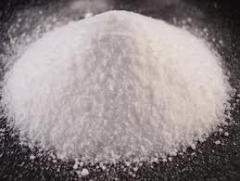Boric acid
| Infobox on Boric acid | |
|---|---|
| Example of Boric acid |  |
| Facts | |
| Origin | - |
| Stowage factor (in m3/t) | - |
| Humidity / moisture | - |
| Ventilation | - |
| Risk factors | See text |
Boric acid
Description
Boric acid, also called hydrogen borate, boracic acid, orthoboric acid and acidum boricum, is a weak acid of boron often used as an antiseptic, insecticide, flame retardant, neutron absorber, or precursor to other chemical compounds. It has the chemical formula H3BO3 (sometimes written B(OH)3), and exists in the form of colourless crystals or a white powder that dissolves in water. When occurring as a mineral, it is called sassolite.
Boric acid, or sassolite, is found natively in its free state in some volcanic districts, for example, in the Italian region of Tuscany, the Lipari Islands and the US state of Nevada. In these volcanic settings it issues, mixed with steam, from fissures in the ground. It is also found as a constituent of many naturally occurring minerals – borax, boracite, boronatrocaicite and colemanite. Boric acid and its salts are found in seawater. It is also found in plants, including almost all fruits.
Boric acid comprises colourless, odourless scales or white powder; stable in air. It is soluble in boiling water, alcohol and glycerol. Non combustible.
Application
Heat-resistant (borosilicate) glass, glass fibres, porcelain enamels, boron chemicals, metallurgy (welding flux, brazing copper), flame retardant in cellulosic insulation, mattress batting and cotton textile products, fungus control on citrus fruits, ointment and eye wash (water solution only), nickel electroplating baths.
Shipment / Storage
Usually packed in bags.
Keep container tightly closed. Keep container in a cool, well-ventilated area. Do not store above 23°C.
See also: http://www.chemicalland21.com/industrialchem/inorganic/BORIC%20ACID.htm
Risk factors
Toxic via ingestion. Use only weak solutions. Irritant to skin in dry form.











